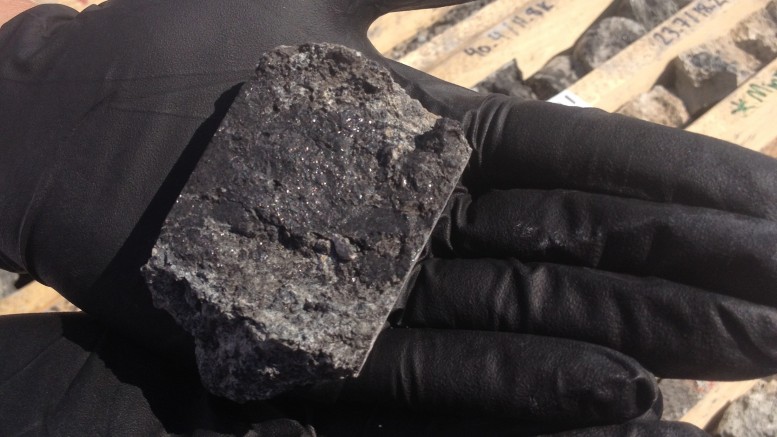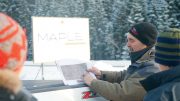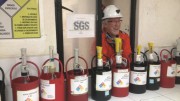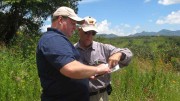NORTHERN SASKATCHEWAN — Handling drill core caked with uraninite — a radioactive, uranium-rich ore mineral — isn’t exactly for the faint of heart, but with grades north of 25% U3O8, Fission Uranium (TSX: FCU) at its Patterson Lake South (PLS) project, 150 km north of the community of La Loche, Sask., doesn’t appear to have any other choice.
The company’s latest drill results revealed a 4-metre intercept grading 26% U3O8, within a broader interval of 11 metres of 10% U3O8, starting at 159 metres deep. The drill hole was centered on the R840W zone, a lobe of mineralization located 500 metres southwest of the project’s flagship Triple R deposit.
Triple R is well-known in the uranium space as being the most high-grade, near-surface deposit near Saskatchewan’s Athabasca basin, a region that accounts for 20% of global uranium supply.

Location map for Fission Uranium’s Patterson Lake South property near Saskatchewan’s Athabasca Basin. Credit: Fission Uranium.
The deposit contains 2 million indicated tonnes of 1.8% U3O8 and 785,000 inferred tonnes of 1.8% U3O8, which includes a high-grade core of 45 million lb. at 18.2% U3O8 as indicated, and 13.9 million lb. at 25.1% U3O8 as inferred, starting at 50 metres below surface.
For the past year Fission has delivered high-grade drill results at the property, with a 24,000-metre drill campaign to expand the resource at Triple R.
To get a firsthand update on the company’s progress, The Northern Miner, along with a handful of analysts, took a one-hour float plane journey from the fire-ravaged town of Fort McMurray, Alta., and met with president, chief operating officer and chief geologist Ross McElroy at one of the main offices at the PLS camp.
“As it stands, the Patterson Lake South trend is already the largest mineralized footprint in the Athabasca basin — it eclipses the size of Cigar Lake — so it’s already quite impressive,” McElroy said during a presentation.

Fission Uranium’s has focused this year’s drilling campaign on the R840W and R1620E zones, with the aim to incorporate the zones into Triple R’s resource next year. Credit: Fission Uranium.
A large map draped over a table shows mineralization at PLS as four main lodes along a 2.6 km, east-trending structural corridor. From east to west, the zones are called R1620E, R780E, R00E and R840W.
The Triple R deposit encompasses the R780E and R00E zones, which strike for 1.1 km, but are separated by a 225-metre gap.
Whether R780E, R00E or the other zones on the property connect is a question that Fission is trying to answer.
“In the big picture they occur on the same trend, but when you get into them there can be multiple parallel, mineralized structures,” he says. “They’re like vein-hosted gold deposits. They pinch and swell — sometimes coalesce or bifurcate — and as you move higher up the grade scale, they can become more discontinuous.”
For McElroy, the expansion potential at PLS is just a matter of drilling.
Latest results from R1620E include 9.5 metres of 13.7% U3O8 within 27 metres of 5% U3O8, and 26.5 metres of 3.6% U3O8, including 9 metres of 8.6% U3O8.
“We think R1620E tells an interesting story. Over the last couple of years we’ve only seen low-grade mineralization there and never gave it much attention, but this past winter we found R780E-like widths and grades,” he says. “When you look at the deposit as a whole, it’s not that big of a footprint for 100 million lb. uranium — you can drill 5 metres beside the deposit and only see smoke. With enough holes we may be able to put all this together and prove a more continuous orebody.”
He adds that Fission plans to incorporate results from R840W and R1620E into a resource estimate for Triple R next year.

Aerial view of Fission Uranium’s Patterson Lake South camp near Saskatchewan’s Athabasca Basin. Credit: Lesley Stokes.
Outside of the office building, the view of Fission’s property resembles a large sandbox. The uranium-encrusted rocks below are overlain by a variably thick package of glacial-derived sand and silt, which kicks up dust in the wind.
A lake up to 6 metres deep covers the Triple R deposit and R1620E, whereas the rest of the prospects are land-based.
If Fission develops Triple R, it would need to isolate the deposit from the lake by way of a 3.3 km long perimeter dike and slurry cut-off wall, similarly used at Dominion Diamond’s (TSX: DDC; NYSE: DDC) Diavik diamond mine in the Northwest Territories, and Agnico Eagle Mines’ (TSX: AEM; NYSE: AEM) Meadowbank gold mine in Nunavut.
McElroy says that an estimated $270-million wall is needed for a 1,000-tonne-per-day open-pit and underground operation.
“It’s expensive, but it will allow us to do open-pit mining, which has inexpensive operating costs. You can move product a lot cheaper with a truck and shovel than you can by selectively mining it out underground,” he says.

Drill rigs on the R1620E zone. The lake reaches a maximum depth of 6 metres. Credit: Lesley Stokes.
According to a preliminary economic assessment published in September last year, Triple R’s 14-year operation could deliver a 34.2% after-tax internal rate of return and a $1-billion after-tax net present value at a 10% discount rate, assuming a US$65 per lb. U3O8 long-term price.
Total preproduction capital costs, which includes the dike and slurry wall, adds up to $1.1 billion, whereas operating expenses at US$14.02 per lb. would make Fission one of the world’s lowest-cost uranium producers.
The prospect of mining at Triple R attracted China’s state-owned CGN Mining to exchange $82.2 million for a 20% stake in Fission last December. CGN also agreed to buy 20% of the annual uranium production from the PLS property, with an option to buy another 15%.
Dev Randhawa, chairman and CEO of Fission, tells The Northern Miner after lunch that the landmark deal was a way to “derisk the project, because we knew we wouldn’t have to raise money for the next three to five years.
“We’re trying to be cautious, and aware that the uranium price might not go anywhere yet,” Randhawa says. “Having CGN as a partner has altered our strategy. They want to produce within 20 years, and that’s not a bad thing. So on one hand we’re moving towards prefeasibility, and on the other we’re looking elsewhere on the property for discoveries.”

Geophysical conductors in electromagnetic geophysical surveys on Fission Uranium’s Patterson Lake South property. Credit: Fission Uranium.
Fission is aiming for shear-hosted uranium deposits, unlike the traditional unconformity-hosted deposits seen elsewhere in the Athabasca basin.
The uranium-rich shear zones on the property are coated with hydrothermal graphite, which serves as an excellent conductor in electromagnetic (EM) geophysical surveys.
With over 100 EM signatures identified across Fission’s 311 sq. km property, the company has its pick of the crop.
“The electromagnetic trend is really quite big, it goes for tens of kilometres,” McElroy says. “If you look at it from a regional scale, further north you’ll see NexGen’s Arrow on the exact same conductive corridor, then you get into Purepoint Uranium Group, Cameco and Areva’s Hook Lake property.
“There’s every reason to believe we could have similar success on the property’s other conductors,” he adds. “We’ve taken Triple R to the next level … and the next thing that will move the needle on the stock is a discovery.”






Be the first to comment on "Site visit: Fission poised for growth at Patterson Lake South"